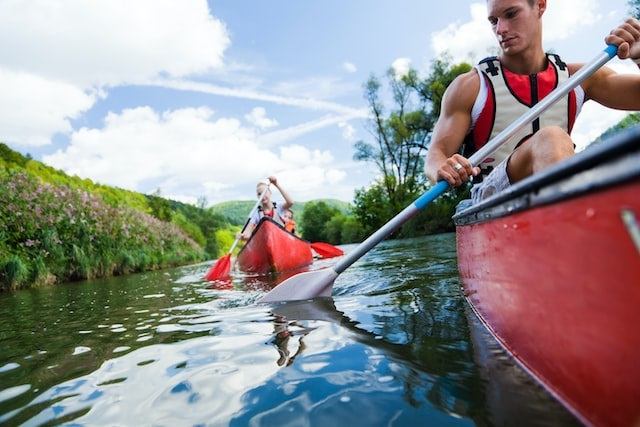There doesn’t seem to be much to a canoe paddle. It’s easy to identify that there are three main parts such as the shaft, the blade, and the handle. However, within those three simple parts is created the freedom and ability to propel oneself across the surface of the water with grace, power, and ease. When thinking in those terms there must be a lot that goes into those three simple parts of a canoe paddle. Here are some facts about each part of the anatomy of a canoe paddle.
Canoe Paddle Blades
There are four basic design features that make up a canoe paddle blade. There is the width, length, shape of the blade, and contour of the face of the blade.
The longer that the paddle blade is the deeper the paddle will need to be placed in the water. The larger the blade’s length and width the more power that can be generated during the canoe stroke. The downside to a larger blade is that it requires more effort and strength to pull through the water. Thinner and smaller blades are easier to maneuver in the water but won’t generate much power.
The shape of the blade can take a few forms. There are rounded ends and squared ends. Rounded paddle blades are good for beginners as they are more forgiving. Squared paddle blades can cause a beginning paddler to be off balance due to it getting caught in the water.
The contour of the face and back of the blade is also a design feature in some higher
end paddles. Most canoe paddles are just flat on both sides. Some, however, are concave on the power face and convex on the back face. This helps a little with the power of the stroke.
Canoe Paddle Shaft
There are a few things to note about canoe paddle shafts. First is the amount of flex or rigidity that the shaft allows. A flexible shaft will absorb impact and shock better. A rigid paddle offers more responsiveness and control. The canoe shaft material is the main factor driving this feature.
The next feature incorporated into canoe paddle shafts is whether it is straight or bent. Most canoe paddles have straight shafts. Straight shafts are good for maneuvering and therefore the main choice of whitewater canoeists. Bent shafts compensate for the changing angle that the blade has with the water throughout the stroke. Bent shafts give the paddle a more vertical orientation during the power phase of the forward stroke thereby increasing the paddle stroke efficiency. The greater the angle (up to a point), the more efficient it is for paddling over extended periods.
The last important feature of paddle shafts is the shape of the shaft. Some are perfectly round while others are oval. Round shafts are more typical, while oval shafts are often more ergonomic and comfortable. And to further mix it up, some round canoe paddle shafts have an oval section where the paddle is held with the lower hand.
Canoe Paddle Grip Handle
There are two main types of canoe paddle grips that affect how a paddler holds a canoe paddle. There is the standard T-grip. This is the most widely used type of grip. Additionally, it is the favorite type of grip of whitewater paddlers due to the greater control that the grip offers. The other type of grip is a contoured grip that fits in the palm of the hand. It can be stubby and rounded. These types of grips are often preferred in flatwater paddling as the contour offers better ergonomics than the standard T-grip.
Other Canoe Paddle Features
There are of course other features that canoe paddles offer. For instance, some paddles have a protective strip along the tip of the blade to protect against hitting rocks. There are paddles with foam padding along the shaft to give the hand a comfortable place to hold. There are even adjustable length paddles so you can properly size your canoe paddle to the canoeist.

